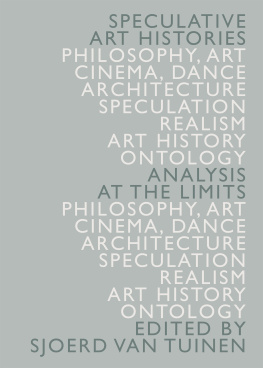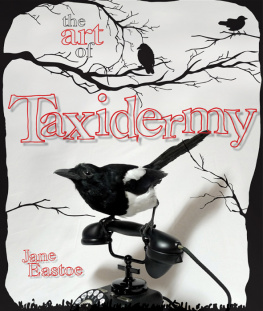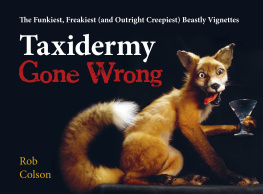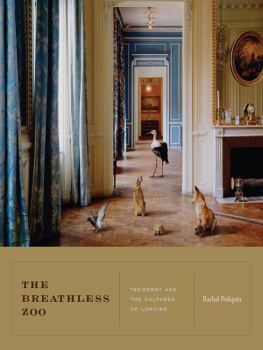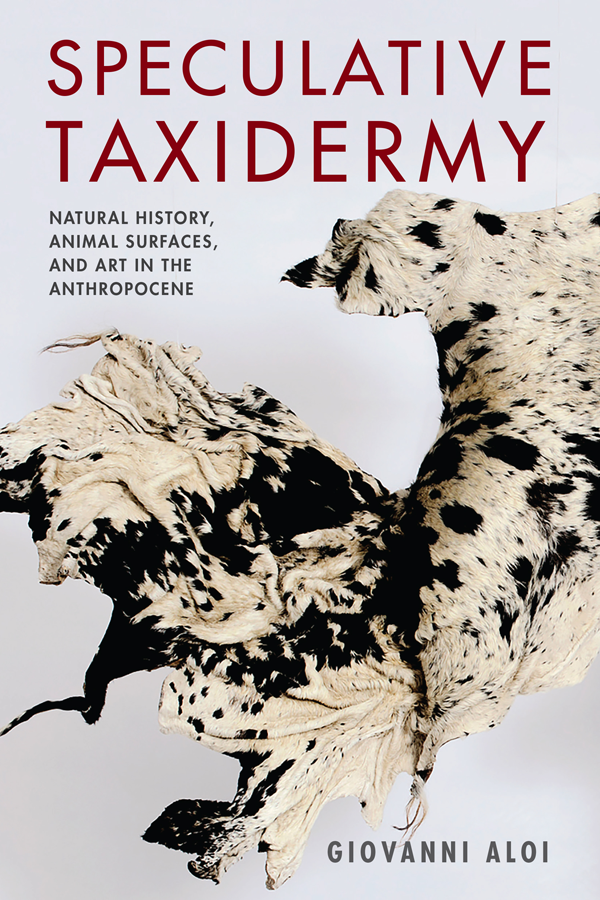Contents
Guide
Pagebreaks of the print version
SPECULATIVE TAXIDERMY
CRITICAL LIFE STUDIES
CRITICAL LIFE STUDIES

Jami Weinstein, Claire Colebrook, and Myra J. Hird, series editors
The core concept of critical life studies strikes at the heart of the dilemma that contemporary critical theory has been circling around: namely, the negotiation of the human, its residues, a priori configurations, the persistence of humanism in structures of thought, and the figure of life as a constitutive focus for ethical, political, ontological, and epistemological questions. Despite attempts to move quickly through humanism (and organicism) to more adequate theoretical concepts, such haste has impeded the analysis of how the humanist concept of life is preconfigured or immanent to the supposedly new conceptual leap. The Critical Life Studies series thus aims to destabilize critical theorys central figure, lifeno longer should we rely upon it as the horizon of all constitutive meaning but instead begin with life as the problematic of critical theory and its reconceptualization as the condition of possibility for thought. By reframing the notion of life criticallyoutside the orbit and primacy of the human and subversive to its organic formsthe series aims to foster a more expansive, less parochial engagement with critical theory.
Luce Irigaray and Michael Marder, Through Vegetal Being: Two Philosophical Perspectives (2016)
Jami Weinstein and Claire Colebrook, eds., Posthumous Life: Theorizing Beyond the Posthuman (2017)
Penelope Deutscher, Foucaults Futures: A Critique of Reproductive Reason (2017)
SPECULATIVE TAXIDERMY
NATURAL HISTORY, ANIMAL SURFACES, AND ART IN THE ANTHROPOCENE

GIOVANNI ALOI
Columbia University Press
New York

Columbia University Press
Publishers Since 1893
New YorkChichester, West Sussex
cup.columbia.edu
Copyright 2018 Giovanni Aloi
All rights reserved
E-ISBN 978-0-231-54321-7
Library of Congress Cataloging-in-Publication Data
Names: Aloi, Giovanni, author.
Title: Speculative taxidermy : natural history, animal surfaces, and art in the anthropocene / Giovanni Aloi.
Description: New York : Columbia University Press, 2018. | Series: Critical life studies | Includes bibliographical references and index.
Identifiers: LCCN 2017038409 | ISBN 9780231180719 (pbk. : alk. paper) | ISBN 9780231180702 (cloth : alk. paper)
Subjects: LCSH: Dead animals in art. | Human-animal relationships in art. | Art, Modern21st centuryThemes, motives. | TaxidermySocial aspects.
Classification: LCC N7660 .A57 2018 | DDC 709.05dc23
LC record available at https://lccn.loc.gov/2017038409
A Columbia University Press E-book.
CUP would be pleased to hear about your reading experience with this e-book at .
Nandipha Mntambo, Titfunti emkhatsini wetfu ( The Shadows Between Us ), 2013 ( partial view, left ). Cow hide, resin. Photo by Jean-Baptiste Beranger. Courtesy Andrhn-Schiptjenko, Stockholm.
The cover design is based on a concept provided by the author.
CONTENTS

MARK DION AND ROBERT MARBURY
T he research and writing in this book are the result of many years of exciting discussions with colleagues, students, artists, curators, and friends. Needless to say, I will not be able to mention everyone here because much of the ground research for this book dates back to 2010, when I embarked on my PhD on taxidermy in contemporary art under the supervision of Lynn Turner and Astrid Schmetterling at Goldsmiths University of London. Lynns critical feedback, guidance, knowledge, and genuine enthusiasm for the philosophical question of the animal vastly expanded my own conception of the subject in an invaluable way. Astrid spurred me to start my academic career during my postgraduate studies in art history at Goldsmiths, and her influence on my work has been substantial. Other memorable and highly influential figures from my Goldsmiths years are Gavin Butt, Simon OSullivan, and Brendan Prendeville, who I thank for their thought-provoking seminars and invitations to think about realism and posthumanism from new and challenging perspectives. The first stage of this project is indebted to and informed by conversations with Steve Baker, Rod Bennison, Ron Broglio, Helen Bullard, Jonathan Burt, Mark Fairnington, Tessa Farmer, Diane Fox, Erica Fudge, Rikke Hansen, Garry Marvin, Susan McHugh, Austin McQueen, Marlena Novak and Jay Alan Yim, Cecilia Novero, Jennifer Parker-Starbucks, Nigel Rothfels, Brynds Snbjrnsdttir and Mark Wilson, Jessica Ullrich, and Joe Zammit-Lucia. Perhaps most importantly, much of the initial animal studies platform upon which the key arguments of this book stand was developed at the London meetings of the British Animal Studies Network held between 2007 and 2009, which I religiously attended. Many chapters featured in this book were presented at conferences in Europe and the United States. I therefore thank the scholars and graduate students who have helped me to fine-tune key arguments and ideas.
Despite its origin, this book is not an adapted PhD thesis. The end of my PhD studies felt like the beginning of something important, and thus I wanted to begin a new journey on the grounds of what I had learned through my research at Goldsmiths. The concept of speculative taxidermy emerged then. After I relocated to Chicago and found time to put Foucault on one side, I could focus on the emerging philosophies of object-oriented ontology and new materialism. This second stage of this project was substantially shaped by the reading materials and by those who attended the 2014 and 2015 incarnations of Following Nonhuman Kinds, a Chicago-based reading group organized by Rebecca Beachy, Caroline Picard, and Andrew Yang. From these meetings, friendships and important conversations on the subject of taxidermy and the nonhuman have also developed with, among others, artists Doug Fogelson, Jenny Kendler, Karsten Lund, and Claire Pentecost. I would like to mention the influence of the Animal/Nonhuman Workshop meetings held at the University of Chicago. Also important to the content of this book have been the conversations on nonhuman representation in digital media held at Digital Animalities, a project funded by the Social Sciences and Humanities Research Council involving a cohort of international animal studies scholars including, among others, Jody Berland, Matthew Brower, Robert McKay, Anat Pick, Nicole Shukin, and Tom Tyler. I also wish to thank the undergraduate students at the School of the Art Institute of Chicago who, every year, enroll in my class Surface Tensions: Taxidermy in Contemporary Art. Their insights, discussions, and motivation to get to the bottom of what taxidermy can bring to art practice keep my interest in this subject constant.
I am particularly grateful to all artists featured in this book for their kind collaboration and patience in answering my questions and helping with clearing permission rights for the use of their images. Most especially I would like to thank Robbi Siegel at Art Resource, Inc.; Sylvia Bandi and Julia Lenz at Hauser and Wirth; Gina C. Guy at the Robert Rauschenberg Foundation; Sinazo Chiya at Stevenson Gallery; and Myungwon Kim at Tanya Bonakdar Gallery. The reproduction of images in this book has been made possible by a Faculty Enrichment Grant awarded by the School of the Art Institute of Chicago in April 2016.


